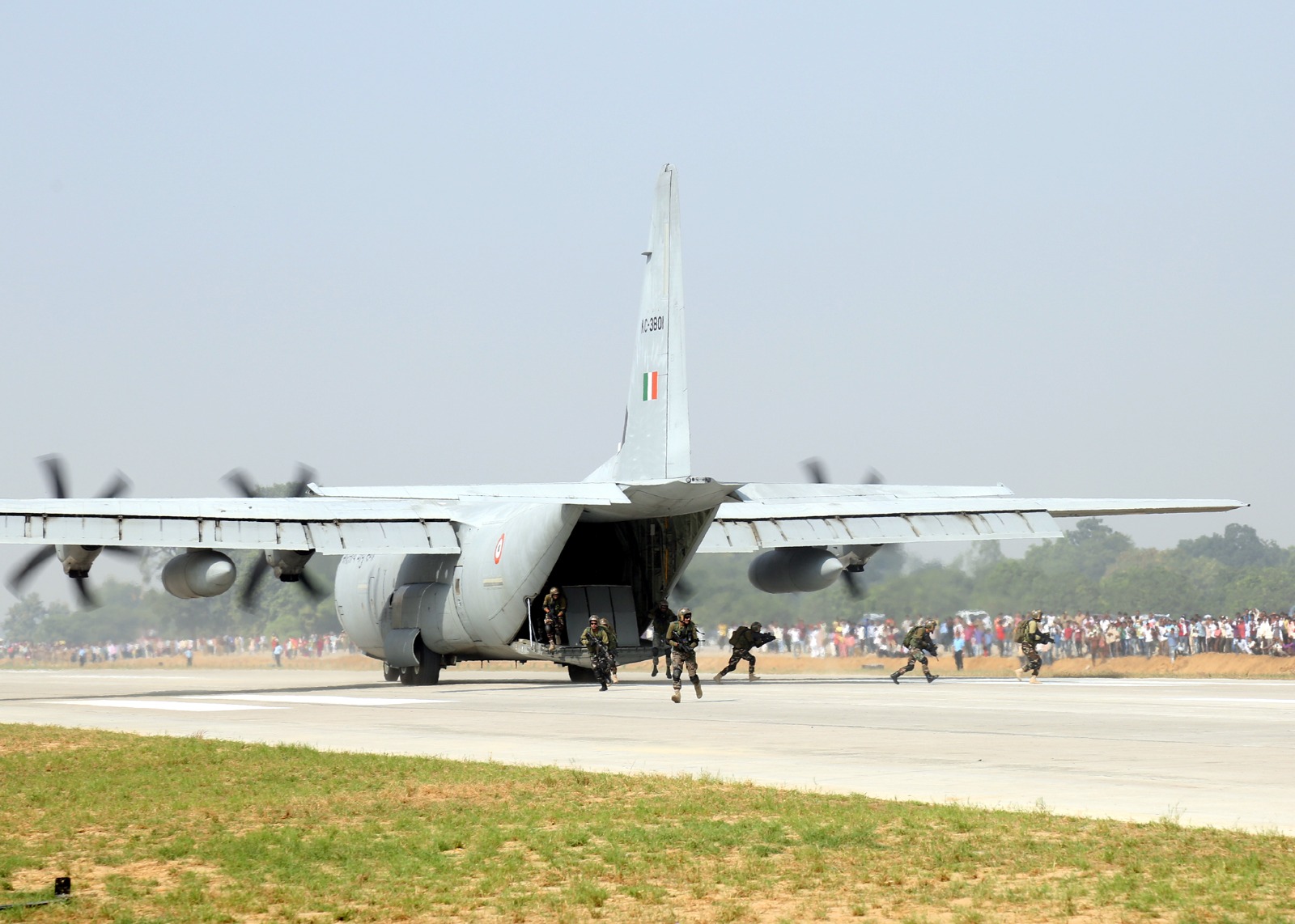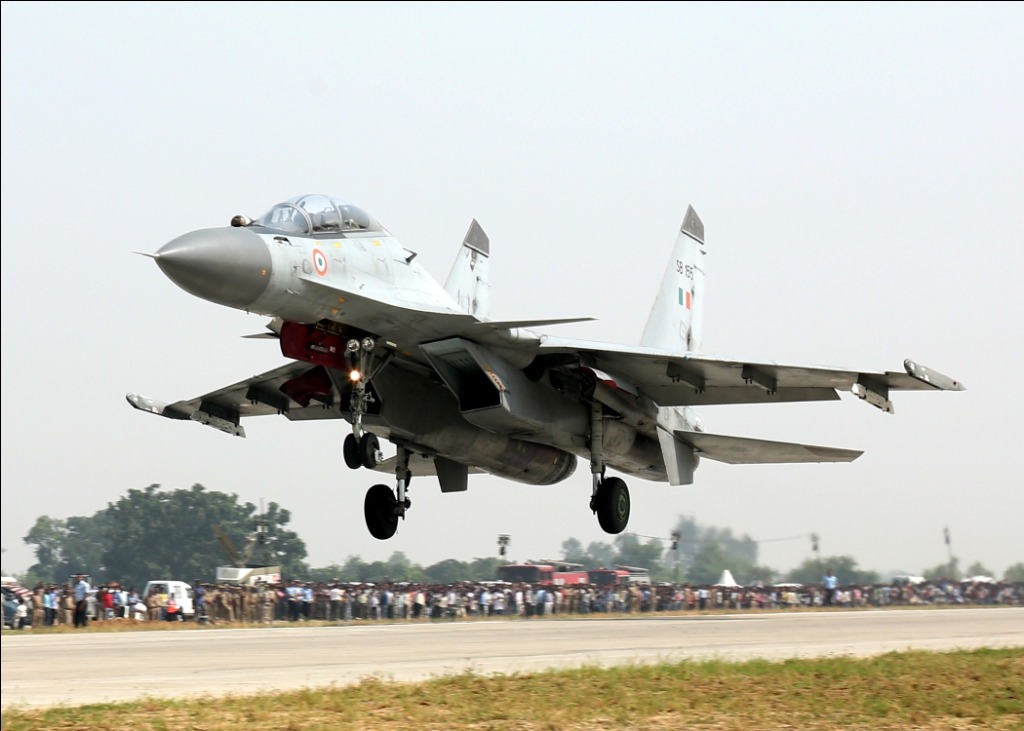OPED By Air Marshal Anil Chopra
Traditionally, the air forces created large airbases with colossal infrastructure. This included runways, operational areas, storage hangars, significant tarmacs with sun shelters, maintenance facilities and labs, armament and fuel storage, administrative rooms, and housing, among others.
Air Forces with global reach had to build these in their territories abroad or in friendly foreign countries. All this cost a lot of money and time to develop and operate. When operational requirements were reduced after significant conflicts, like what happened after World War II, most of these airbases had to be abandoned and became disused.
Also, after the end of the Cold War, the US Air Force (USAF) significantly reduced its foreign airbases. In the case of India, the initial airbase locations and other operational infrastructure were Pakistan-centric. Later, there was a need to shift focus towards the northern border.
This required a significant exercise. The global partnerships also keep changing. Having bombed Germany for years in World War II, the West became closer to and made Germany join NATO. USAF has had to alter relations with the Philippines and many West Asian countries.
Afghanistan is another example where the US had to vacate after 20 years and left modern airfields intact. Leaving behind massive infrastructure is a costly proposition and also has operational implications.
Targeting Large Permanent Airbases
Satellite-based Intelligence, Surveillance, and Reconnaissance (ISR) capabilities today allow full details of a permanent airbase. Modern weapons have global strike capability with a high degree of precision and lethality. Airbase is a high-value target. The best air defenses may be unable to stop all the strike weapons. These can, therefore, cause considerable damage.
For example, Guam is a major USAF airbase in the Pacific; to take on China, the Americans would have to defend at any cost. Conversely, the Chinese are building their operational inventory to neutralize it.
Similarly, some Indian airbases, such as Ambala, which is relevant to both Pakistan and China contingency, are high-value assets. Also, it is not possible to build large airfields in areas where the conflict starts after a trigger event.
In such a case, one has to depend on regional partners’ assets, as the US did during operations against Iraq by using Saudi airbases like Dhahran. This, too, may not always be possible because of local political sensitivities.
Agile Air Operations Concept
The ability to project power cannot be compromised. Major air forces of the world, especially those that have to plan for out-of-area contingencies, have thus begun evolving into a new concept where self-contained mobile air force units are created that will use specially designed highway stretches as operating surfaces.
Such a concept has existed in the Indian Air Force (IAF) mainly to take over an enemy or disused airfield. The highway stretches exist in most major countries, including India.
A forward arming and refueling point (FARP) or forward area refueling point is an existing NATO term for an area where aircraft (typically helicopters) can be refueled and re-armed at a distance closer to their area of operations than their primary operating base. This was also used for Harrier vertical take-off jet operations. The concept at a bigger scale is meant to be applied to fighter operations.
The USAF has formalized and introduced the Agile Combat Employment (ACE), a proactive scheme for agile air power projection at short notice. The concept requires the identification of road/highway stretches that have been prepared for possible air operations. These stretches are duly marked for air operations.
No access roads are crossing these stretches. Yet small aircraft parking and servicing aprons have been created at either end. Such aprons would be suitably camouflaged and may have forest-like surroundings. The Command and Control (C2) will be through minimal secure satellite mobile communications. Each launch pad will have man-portable AD systems. It will have an element of counter-drone capability.
A mobile servicing cum replenishing unit is specially designed for this purpose. This includes vehicles for Fuel, Oils, and Lubricants (FOL) and dedicated armament carrying and loading platforms/vehicles.
Usually, their requirement will be to only service around four aircraft at a time. There will be a universal power generation unit for lighting and powering the aircraft. The storage and replenishment point for these vehicles could be a ubiquitous warehouse in the neighborhood. It will require minimal manpower.
In case of a significant technical problem on the aircraft, the modern fault diagnostic system will transmit information to the repair base, which could be 100 kilometers away. A crack team of specialists would be heli-lifted for further repairs.
Modern fifth-generation aircraft that require conformal carriage would have limitations on the quantum of onboard fuel. They would invariably require aerial refueling. With very long-range aerial missiles, the Flight Refuelling Aircraft (FRA) will be forced to maintain farther from the frontline. The ACE concept will be advantageous in that context, too.
Leveraging local commercial markets can alleviate distribution system stress. It can thus be seen that infrastructure requirement is minimal. A central logistics and maintenance support center, like a hub-and-spoke setup, can feed a cluster of launch pads or contingency locations. Such launch and recovery pads can be built in more significant numbers, often at short notice. ACE offers excellent flexibility.
ACE will work well, especially since, in a contested environment, air superiority may not be easy to achieve.
Complicating Enemy Targeting
The ACE will certainly complicate the enemy’s targeting process and create operational dilemmas for the adversary. The system will be highly mobile. After forward objectives are achieved, the launch pad can be deactivated.
In case of advancing forces, fresh pads can be created ahead. All launch pad relocations will be like a proactive maneuver and alter adversary or enemy understanding of friendly intentions and capabilities. It will be an aggressive use of mobility and dispersion of forces and assets.
ACE positions the force for observing, orienting, deciding, and acting (OODA) loop in all domains. It will increase survivability and support repositioning forces for follow-on operations. It will also complicate the adversary’s anti-access and area-denial capabilities. It will create a dilemma and complicate the adversary’s operational response and tempo. This will make targeting by adversaries much more complex and put a premium on timely intelligence.
India’s Highway Landing Strips
All the new expressways in the country have 3-kilometer or longer straight stretches for IAF aircraft to operate. The highway stretches have approach paths clear from obstacles as per specifications. The road stretches have runway markings precisely as they are at IAF airfields. The side berms have been kept clear of obstructions.
The highway pole lights have been replaced with ground lighting for aircraft operations. At the ends of these highway runway stretches is a larger area for the aircraft to be able to turn around.

Securing these strips and the IAF assets is being managed by the IAF in close coordination with civil police or para-military agencies. IAF has been doing landings and take-off operations from most of these stretches.
Such highway strips are created for emergencies and war-like situations that may render air force bases inaccessible due to bombing or other calamities like earthquakes, as in Bhuj in January 2001.
The Indian government has realized the operational importance of these strips and is now accelerating the process of building many more such strips. Various government departments could now explore the possibility of greater civil use during calamities.
Nearly 24 expressways with a combined length of almost 5,147 km are operational in India. Another 8,772 km are under construction, and many more are under planning. Most expressways are fit for fighter jet operations.
The expressways connecting Jammu and Kashmir, Punjab, Haryana, Uttar Pradesh, Bihar, West Bengal, Northeastern states, Rajasthan, and Gujarat have immediate operational significance due to proximity to borders.
Expressways in southern states are essential as India shifts to greater Indian Ocean focus. The concept is interesting for the IAF to implement, and it will significantly increase freedom of action for the IAF.
IAF Preparation For Operationally Limiting Environment
Each major airbase should initially be given a few expressway stretches to manage and build ACE-related support infrastructure and logistics support. Tailor-able force packages would have to be evolved.
It will require rapidly establishing short-duration air traffic services (ATS) under austere conditions for both rotary-wing and fixed-wing assets on an expeditionary basis for missions of short duration and limited scope. Quick reaction teams (QRT) would have
to be created.
The aircrew would have to train to land and operate from such locations regularly. The mission may not land at the same launch pad and be retrieved at a far-off place, giving operational flexibility.
Air warriors would have to be trained for skills to operate in a contested, degraded, and operationally limited environment to execute distributed operations that increase survivability while generating combat power.
They will have to work with minimal equipment and personnel footprints. Operating area Standard Operation Procedures (SOP) will have to be evolved. These list equipment and supply pre-positioning, scalable logistics packages, and resupply sources.
IAF already operates in a networked environment. Secure satellite data links will feed relevant operational mission information, including situational awareness and operational
priorities. It will make IAF operations light, lean, and agile. IAF will be able to redistribute posture through operational unpredictability afforded by the increased number of dispersed locations.
Location shifts could mean command and control shifts and the SOPs for flexibility must be worked out. ACE will require multi-tasking air warriors to accomplish tasks outside of their core Air Force specialty. This is a concept well in place in most modern air forces. This would have to strengthen in IAF, too.
Leveraging advances in artificial intelligence, automation, augmentation, and human-machine teaming would make operations smoother and more effective and increase the ability of commanders to develop, execute, or transition between missions rapidly.
Dispersal plans from specific permanent airbases must be put in the operational contingency plans. Only a few launch pads, among the many, will be occupied at any given time, and these will be in the active war theatres.
Lastly, the QRTs will also be used for outside area contingencies, especially when landing at semi-prepared surfaces, as IAF landed the C-130 in Wadi Sayyidna, Sudan, during Operation’ Kaveri.’

Options & Way Ahead For India
The concept is a revolutionary change in how the air forces think about and conduct operations. It is a forward-looking concept with greater flexibility and “punch for the buck.” It is for offensive and defensive operational approaches, especially in contested environments.
This will enable quicker and more effective offensive operations following the adversary’s conflict initiation. It allows dispersed forces to adapt and prevail despite uncertainty.
Closer to the Tactical Battlefield Area (TBA), such operations can be supported or secured by the Indian Army. If Ukraine had applied a similar concept, a significant part of its air force would still have been operational.
A large adversary like China wields a disruptive and dangerous operational reach with mass, precision, and speed. They can challenge India’s ability to project power from large airfields by targeting them. The concept will mitigate the adversary’s technological advancements in ISR and its advantage in long-range strikes and reduce risk to own airbases and assets.
It will adjust to the changing operational environment and the evolving character and phase of war. The ACE concept shifts operations from centralized physical infrastructures to a network of smaller, dispersed locations that are operationally viable.
ACE concept potential will be maximized in a highly lethal, hyperactive battlefield. The operating stretch of the expressway may be changed on a required basis.
IAF may run a few pilot projects to begin with. After that, there will be a need to train to make the Air Force more flexible and agile. The scheme should also work well in advanced landing grounds like Nyoma in Ladakh. This could also work well on Island territories. Out-of-the-box thinking often finds operationally reasonable and viable solutions.
- Air Marshal Anil Chopra (Retired) is an Indian Air Force veteran fighter test pilot and is currently the Director-General of the Center for Air Power Studies in New Delhi. He has been decorated with gallantry and distinguished service medals while serving in the IAF for 40 years. He tweets @Chopsyturvey
- Follow EurAsian Times on Google News




